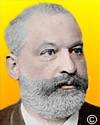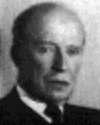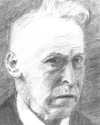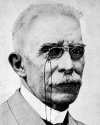
On 8 Oct 1904, Clemens Winkler, German chemist died. Although his name may be unfamiliar to you, he is notable for discovering a new element. (Its name is a quiz question below.)
His eventual discovery of this new element was the result of months of work in the laboratory on the mineral argrodite.
An account of Winkler's discovery of the new element in The Discovery of the Elements (1934) makes interesting reading. You may be surprised by the crucial step that made all the difference in finding the new element when his months of previous efforts had been fruitless.

On 8 Oct 1823, the Erie Canal was inaugurated. It became a vital transport route, an economic engine for New York and helped propel the Industrial Revolution in the U.S. It stretched 363 miles across upstate New York from Buffalo on Lake Erie to Albany on the Hudson River. Today's book pick is: Wedding of the Waters: The Erie Canal and the Making of a Great Nation, by Peter L. Bernstein, who describes how linking the Atlantic seaboard with the American interior was the first great feat of engineering undertaken by the infant American republic. Bernstein relates this riveting story of American ingenuity, featuring a rich cast of characters, including not only political visionaries like Washington and Jefferson but also a huge platoon of Irish diggers as well as the canal's first travellers. A stunning achievement, the canal was hacked through a densely forested pass in the Appalachian Mountains using only axes, shovels, low-grade explosive power, beasts of burden, and some ingenious devices. The engineers and workers created locks, bypassed rapids and waterfalls, and adjusted to countless changes in elevation. This first great macroengineering venture of American history jump-started urbanisation, economic growth and globalisation.
It is available from Amazon, typically about New from $15.80. Used from $1.38. (As of earlier time of writing - subject to change.)
 | The psychopaths are always around. In calm times we study them, but in times of upheaval, they rule over us. |
 | In my opinion the separation of the c- and ac-stars is the most important advancement in stellar classification since the trials by Vogel and Secchi ... To neglect the c-properties in classifying stellar spectra, I think, is nearly the same thing as if a zoologist, who has detected the deciding differences between a whale and a fish, would continue classifying them together. |
 | Die Welt der chemischen Vorgänge gleicht einer Bühne, auf welcher sich in unablässiger Aufeinanderfolge Scene um Scene abspielt. Die handelnden Personen auf ihr sind die Elemente. The world of chemical reactions is like a stage, on which scene after scene is ceaselessly played. The actors on it are the elements. |
| Before you look at today's web page, see if you can answer some of these questions about the events that happened on this day. Some of the names are very familiar. Others will likely stump you. Tickle your curiosity with these questions, then check your answers on today's web page. | |
| Births | |
 | Ejnar Hertzsprung, born 8 Oct 1873, was a Danish astronomer who classified types of stars by relating their surface temperature (or colour) to their absolute brightness. A few years later, working with another scientist, Hertzsprung illustrated this relationship graphically in a diagram now known by both their names. It has become fundamental to the study of stellar evolution. What is the name of the second scientist with whom he prepared the graphical diagram? |
 | A French chemist, born 8 Oct 1850, is best known for the principle that makes it possible to predict the effect a change of conditions (temperature, pressure, and concentration of reaction components) will have on a chemical reaction. This principle proved invaluable in the chemical industry for developing the most efficient chemical processes. Can you name this scientist? |
| Deaths | |
 | Clemens Alexander Winkler (1838-1904) discovered a new element (6 Feb 1886). He had a background in managing a cobalt glassworks and then on the faculty of the Freiberg School of Mining, when he discovered the new element in the mineral argyrodite. He named it for his country. What was the element he discovered and named? |
| Events | |
 | On 8 Oct of a certain year, Karl Ludwig Nessler, a German, demonstrated the first “permanent wave” for hair, to an invited audience of hair stylists, at his beauty salon in Oxford Street, London. The hair was soaked with an alkaline solution and rolled on metal rods which were then heated strongly. In what decade did this event occur? |
Fast answers for the previous newsletter for October 7: Buckminster Fuller, whose geodesic dome structure they resembled • Niels Bohr • fish • decade containing the years 1954, 1957 • the blind.
 If you enjoy this newsletter, the website, or wish to offer encouragement or ideas, please send feedback by using your mail reader Reply button.
If you enjoy this newsletter, the website, or wish to offer encouragement or ideas, please send feedback by using your mail reader Reply button. Your click on a Facebook, StumbleUpon, or other social button on the site webpages is also a welcome sign of appreciation. Thank you for using them.
© This newsletter is copyright 2020 by todayinsci.com. Please respect the Webmaster's wishes and do not put copies online of the Newsletter — or any Today in Science History webpage. (If you already have done so, please remove them. Thank you.) Offline use in education is encouraged such as a printout on a bulletin board, or projected for classroom viewing. Online, descriptive links to our pages are welcomed, as these will provide a reader with the most recent revisions, additions and/or corrections of a webpage. For any other copyright questions, please contact the Webmaster by using your mail reader Reply button.
--
If you do not want to receive any more newsletters, Unsubscribe
To update your preferences and to unsubscribe visit this link
Executive Real Estate Business Class
-
"It was like a man with wings. It wasn't like anything you'd see on TV or in a monster movie." ...
About the publisher
Search This Blog
Blog Archive
-
▼
2020
(1542)
-
▼
October
(171)
- The Compass: Iceland
- A Very Special Halloween Edition Of Our Scariest S...
- On This Day for October 31 - Luther's Ninety-five ...
- Newsletter for Saturday 31 October.
- CORONAVIRUS UPDATE: Why some people are supersprea...
- October 31: Martin Luther Challenges the Pope, Mic...
- PHOTOGRAPHY: Capturing America's pent-up energy to...
- The Terrifying Story Of The Mothman, The Little-Kn...
- The Roundup Top Ten from History News Network
- On This Day for October 30 - Henry Tudor crowned k...
- Newsletter for Friday 30 October.
- October 30: Tsar Nicholas II 'October Manifesto', ...
- ANIMALS: Will oil drilling spread across spectacul...
- On This Day for October 29 - Collapse of U.S. stoc...
- Newsletter for Thursday 29 October.
- October 29: End of China's One-Child Policy and Lo...
- YOUR WEEKLY ESCAPE: The science of the heebie-jeebies
- SCIENCE: Will every hurricane season be like this?
- The Latest News from History News Network
- On This Day for October 28 - Statue of Liberty ded...
- Newsletter for Wednesday 28 October.
- October 28: Fingerprints, Prohibition and the Blac...
- TRAVEL: When do Americans say they’ll fly again?
- Were vampire hunters real? Subscribe to find out.
- On This Day for October 27 - Anwar Sadat and Menac...
- Newsletter for Tuesday 27 October.
- October 27: China's Population Reaches 1 Billion a...
- HISTORY: Rush of early voters spurs talk of a record
- New This Week on History News Network
- On This Day for October 26 - Park Chung Hee assass...
- Newsletter for Monday 26 October.
- October 26: Beginning of the Red Cross and the Gun...
- FAMILY: When the best advice to your kids isn't yours
- On This Day for October 25 - English triumph at Ag...
- Newsletter for Sunday 25 October.
- October 25: The Great United Nations China Switch ...
- The Compass: Japan
- On This Day for October 24 - United Nations establ...
- Newsletter for Saturday 24 October.
- October 24: Two Great Historical Stock Market Crashes
- CORONAVIRUS UPDATE: How to fight the COVID-19 'inf...
- PHOTOGRAPHY: The best photojournalism of the decade
- What did Cleopatra look like? | Charles and Diana’...
- 11 Spooky Urban Legends Based On Terrifying True S...
- The Roundup Top Ten for October 23, 2020
- On This Day for October 23 - U.S. and French troop...
- Newsletter for Friday 23 October.
- October 23: US National Debt, an Old Fossil and th...
- ANIMALS: They were researching cheetahs. Iran call...
- Love the show Weird But True? Get more WBT with ev...
- Early Holiday Savings at the HISTORY Store
- Introducing the Britannica All New Kids' Encyclope...
- On This Day for October 22 - Cuban missile crisis,...
- Newsletter for Thursday 22 October.
- YOUR WEEKLY ESCAPE: These prehistoric footprints t...
- October 22: Greenwich Mean Time, the Cuban Missile...
- SCIENCE: Will the next generation fight a pandemic...
- On This Day for October 21 - Magellan's discovery ...
- The Latest News from History News Network
- October 21: Battle of Trafalgar, China Occupies Ti...
- TRAVEL: We found 50 stories in 50 states for ‘Amer...
- On This Day for October 20 - Opening of Sydney Ope...
- Newsletter for Tuesday 20 October.
- October 20: On This Day in History
- HISTORY: Why do we have the Electoral College?
- Join photographer Pete Muller for an online conver...
- New This Week on History News Network
- On This Day for October 19 - Surrender of Lord Cor...
- Newsletter for Monday 19 October.
- October 19: On This Day in History
- FAMILY: Letting kids take charge
- The lost heirs of Henry VIII
- On This Day for October 18 - Alaska Purchase appro...
- Newsletter for Sunday 18 October.
- October 18: French Protestants, The Alaska Purchas...
- The Compass: Portugal
- On This Day for October 17 - Mother Teresa awarded...
- Newsletter for Saturday 17 October.
- October 17: Burma Railway, OPEC Oil Embargo and Ra...
- CORONAVIRUS UPDATE: Who will be first in line for ...
- PHOTOGRAPHY: How COVID-19 changed our work
- The 25 Best Horror Movies Of All Time — And The Ch...
- This Week's Roundup Top Ten from History News Network
- On This Day for October 16 - Marie-Antoinette guil...
- Newsletter for Friday 16 October.
- October 16: Battle of Leipzig, Mao's Long March an...
- ANIMALS: The wildlife photo of the year
- Challenge grant: Help unlock important funds for w...
- On This Day for October 15 - Final conference on A...
- Newsletter for Thursday 15 October.
- October 15: Napoleon's Exile, the 1st Oral Contrac...
- YOUR WEEKLY ESCAPE: A murder mystery 430,000 years...
- SCIENCE: Will the next generation fight a pandemic...
- The Latest News on History News Network
- On This Day for October 14 - Battle of Hastings, D...
- Newsletter for Wednesday 14 October.
- Historic Trends in our time may be overcome with g...
- October 14: William the Conqueror, Robert the Bruc...
- The Embarrassing Final Moments Of 10 Revered Histo...
- TRAVEL: Does your wine taste like fire?
-
▼
October
(171)
-
Blogroll
-
About
HistoryFact










0 comments:
Post a Comment